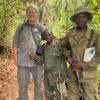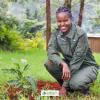AI Identification Models on Thermal Data
6 June 2024 8:30pm
7 June 2024 4:06am
Wow! This dataset seems great and definitely worth trying out. Do you perhaps have a dataset for deer, elk, and those animals of the sort?
I live in the mountainous region so deer are very common and easily hit.
Thank you again
Integrating AI models with camera trap management applications
25 March 2024 7:47pm
6 June 2024 3:18am
Thank you for the update, @pvlun! I have installed and started using the Amazon model. It looks like the model is genus rather than species classifier. It's a shame they don't seem to have puma or panthera classes. Those are key genus for the researchers in Ecuador. Anyway, I should have access to more data when I get the the university in Quito next week. I'll test more then and see what they think of the classes.
6 June 2024 4:14pm
@bluevalhalla those are indeed only genera. And yes, I also found that there are some crucial genera missing. Nevertheless might it still be handy for you to make a rough separation before doing any human verification.
Regarding the video processing: I didn't catch that you're looking for an MD results file that does all frames. MD creates that, but EcoAssist deletes it again (to avoid confusion with the video-level detection file). If you want the frame-level detection file, just out comment these lines. Then you'll have both.
6 June 2024 11:52pm
Answering Peter's question to me above, about how MegaDetector's video processing stuff decides which detection to include in the video-level output file:
- By default, the function that matters just chooses the highest-confidence detection for each category (person/animal/vehicle) as the "canonical detection" for that video (for posterity, that happens here).
- The frame number corresponding to that detection was not previously included in the output (since 99.99% of users would have no way of using this, but it sounds like you're in the other 0.01% :) ), so Peter just submitted a PR to the MegaDetector repo to include this in the output for a video; I'll merge that PR today, so I expect you'll see this in a forthcoming version of EcoAssist.
But ditto what Peter said, it sounds like you actually want the frame-level output file, and Peter gave you a tip about how to get that.
Also FWIW you will almost never want to process every frame of a video, nor will you likely want to train your models on every frame of a video; you're not getting a lot of new information from adjacent frames. Typically when MegaDetector users process videos, I advise sampling videos down to ~3fps, which is usually every 10th frame.
€4,000 travel grants for insect monitoring an AI
6 June 2024 4:49pm
Has anyone combined flying drone surveys with AI for counting wild herds?
14 April 2024 3:40pm
27 May 2024 10:55am
Actually my Raspberry Pi application is a sound localizer not related to image recognition. My image recognition related project runs on Jetsons and higher.
But I think recognizing bugs on a drone would likely be challenging. You would have to have sufficient detail to get good recognition which would be a very narrow field of view and then vibration also becomes an issue.
For example, the trainings on just the coco dataset seems to distill the recognition of people to a multi-segmented thing with bits sticking out. So spiders on camera lens are highly likely to be seen as people. To get better results much more training data is needed. I expect it's also likely to be the case for insects, really large amounts of training data would be needed to tell the difference between different types.
31 May 2024 5:47pm
Hi Johnathan,
There is a Canadian company more or less doing that. They have their own endurance drone and optical/thermal cameras. Very much keyed into surveys and they may have success given the number of helicopter accidents we have had in Western Canada. Not sure if the AI part is there yet.
I know they've done surveys with at least one department here but not much beyond that. I talked to one of the developers their just as a point of interest. The current leadership today looks different than I remember though.
6 June 2024 2:48pm
The camera can be aimed at the greenhouse background, which is like a huge green screen. Inside the greenhouse there's only a few flying insects, and they would all have to fly between the optics and the wall or roof eventually. Or if the bot is flying, have it look upwards.
It's pretty much a programing question. Unfortunately I am not the type of person who is good at both building and troubleshooting hardware, and writing code. I took some programming back in college but I am not sure if I want to get myself up to speed. It's starting to sound like I need a few years of college before I can even get started. Which I already did, too bad none of it counts for anything anymore. Or I guess I can compete in the marketplace with people with real money behind them, which is the only thing that means anything. If you are brilliant and not funded, you might as well be a scarecrow.
How to add a salt water switch
28 February 2020 4:52pm
31 May 2024 5:27pm
Hey Ned,
If you want to add a transmitting component to your tag, let me know. I would happily provide the open-source Argos boards and some free satellite service time.
31 May 2024 6:43pm
Hi, @nedhorning, sounds fascinating! I'm going to listen in to hear how things progress, including with the capacitive sensor described in this thread. That sounds wise as it insulates the electronics.
Also wanted to mention that we use a comparator circuit following a reference design from TI that I can't find at the moment but probably could with more digging if desired. We described its basic design and use in a saltwater switch in this paper (open access) if you want to read a bit more.
6 June 2024 12:11pm
Hello @ThomasGray_Argos ,
I need to add transmitting component, so please provide me the list of these. Actually, I don't know much about it. I am interested in learning new things.
I am new here but a real enthusiast and loving this community so far. I have a background in technology and feel I could help with documentation, at least for starters. If you have any other question apart from this, you can ask. I will try my best to solve your problem.
Auto-Wake a Pi5 without a Pijuice! (Mothbox)
25 April 2024 5:44pm
4 June 2024 8:37pm
Hey Andrew, this is really awesome. I'm sure there are loads of people who ran into the same problems as you and will find your script super useful.
As you might know, we launched The Inventory last month--it's a wiki-style database for all things conservation technology. Based off this post, it sounds like you have some experience using Raspberry Pi in your work. It would be a huge help to the community if you could take some time and leave a review on Raspberry Pi's product page on The Inventory! Your review will help others in the community immensely. Let me know if you have any questions!
5 June 2024 9:56pm
That’s not a lot of power, which is great!
6 June 2024 9:45am
Hi Andrew,
this is great!
Did you consider the Witty Pi 4 L3V7 Real Time Clock (RTC) und Power Management Modul für Raspberry Pi?
(This one has no included battery) or the one with the capacitor?
Greetings from Austria,
Robin
Welcome to WILDLABS!
29 October 2015 5:16pm
5 June 2024 4:13pm
Hi everyone,
I work for Landscape, a connected web and mobile app for the full range of land conservation work from acquisition to stewardship. Hundreds of conservation organizations in the US and Canada use Landscape for land protection project management, field visit data collection, data and document storage, contact and communications tracking, mapping analysis, and collaborative team work.
We are a small team and we're looking for a full stack software engineer/developer to join our team. I'd appreciate your help sharing this posting with any qualified candidates!
5 June 2024 4:28pm
Welcome, @Dan_Ford ! I'm Alex from the WILDLABS community team. We're so happy to have you here.
I definitely recommend sharing that job opening on WILDLABS as a career opportunity, that way it will show up in our biweekly digest and get seen by more people! To do that, just click +Post in the top right corner, then click "Careers" and fill in all the relevant information! We'd be happy to share the opening on our socials as well.
I've also gone ahead and created a page for Landscape on The Inventory, our wiki-style database of conservation tech information. It would be great if you could take a look and add any missing information--I've gone ahead and given you editing access. Also, you can connect your WILDLABS profile to Landscape's page so that people know to contact you with any questions about the organisation! To do this, go to your profile and select “Settings” on your side-bar, and then select the “About you” tab. Search and select your organisation name in the “Organisations(s)” section and click save.
Let me know if you have any questions :)
6 June 2024 9:26am
Hi!
Am Grace Mchome, Msc candidate in wildlife management and conservation at Sokoine University of Agriculture , interested in wildlife conservation and the use of conservation technologies.
Where do I go with technical questions about this platform?
5 June 2024 4:52pm
5 June 2024 6:03pm
@JakeBurton is the go-to person for all questions and problems relating to the website! Jake, can you help with this?
We're in the process of updating some of the content on the website, so thank you for drawing our attention to this!
5 June 2024 6:33pm
Thanks, @alexrood !
6 June 2024 8:20am
Hi @Frank_van_der_Most thanks for flagging that old/broken link. I have updated it to send to this thread here - https://wildlabs.net/discussion/new-platform-help-troubleshooting-bugs
Although as Alex mentioned feel free to come directly in future to me if you have an issue instead. I will reply to your DM!
Testing, Deployment, Solar, Conferences - Mothbox update v3.21
24 May 2024 8:46pm
3 June 2024 10:35am
Thank you for the detailed post. This is amazing!
Have you experimented with ways of reducing power consumption? How much of the power is used by the LEDs vs the RPi? You could try having the LEDs on for less time, or less bright.
Julian
4 June 2024 7:54pm
The LEDs use most of the energy, the UV leds are about 12-15 watts. the pi hangs out around 3 watts. and the white flashing LEDs use about 10 watts each, but we reduced their time to like .8 seconds for a flash photo, so they aren't as much of a big deal.
you basically need a lot of power to make a really bright thing to attract the bugs, but we are testing out some more efficient UV leds
5 June 2024 10:23pm
I was thinking that you might be able to reduce the amount of time the lights were on by blinking them, but this paper seems to show that flickering mostly reduces the number of specimens attracted, though it affects some orders more than others, and, rarely, it increases the number attracted. On the other hand, the numbers of insects captures only seemed to go down by around 50% even with quite extreme flickering (10% duty cycle I.e. light only on 10% of the time) and if that had a big effect on how long the battery lasted it might be worth it, as you could run more capturing sessions between charges.
Prince Albert II of Monaco Foundation call for proposals
5 June 2024 10:01pm
looking for help
5 June 2024 9:38am
5 June 2024 4:19pm
Hi Agripina!
I have always used Browning, and I have found the basic models to be perfectly adequate, using only 6 AA batteries (not 8 like the majority of camera traps). Now I am using the model BTC-8E, which has been a great success due to its excellent definition.
I am from Chile, and I know of a company that imports them. Perhaps you should look for someone in your country that does the same, because importation and customs duties are often a headache.
I recommend you to visit trailcampro.com to read reviews from customers on different brands and models of camera traps.
I hope this information is helpful
5 June 2024 8:32pm
Hii Carolina
Thank you so much for the usefull information.
5 June 2024 8:34pm
Hi Alex
Thank you so much for the imput 🙏
Technical and Client Management Specialist - Wildlife Insights
5 June 2024 7:58pm
UK's ISPF offers ≤ £80.000 grants for international research collaborations
5 June 2024 6:01pm
ICI calls for €20-25M project applications for Colombia
5 June 2024 5:50pm
Open Software Engineer Position at Land Conservation Software Company
5 June 2024 4:37pm
New WildLabs Funding & Finance group
5 June 2024 3:24pm
5 June 2024 4:14pm
6 June 2024 1:38am
6 June 2024 4:16am
VIHAR-2024 deadline extension, June 30th (Interspeech satellite event)
5 June 2024 10:30am
5 June 2024 3:05pm
Thanks for sharing this @nkundiushuti ! I think this post would be better suited as an event, that way it will show up on the WILDLABS event calendar page. Let me know if you have any questions on how to make an event post! You just click the +Post button in the top right corner, then click "event."
Mass Detection of Wildlife Snares Using Airborne Synthetic Radar
7 January 2024 6:50am
28 May 2024 5:06am
Hi @DaveGaynor regarding funding, have you reached out to any lodges? I know that snaring is rife in the Manyaleti ... maybe some of the lodges in the Sabi Sands would be interested in helping you with your goal?
31 May 2024 12:57pm
Aakash, that is a really amazing offer, we really need people capable of analyzing the radar data and used to working with signal processing I will reach out to you now.
4 June 2024 7:52pm
Hi David - have you seen this opportunity? It may be a good one to apply to for support (the Darwin Initiative).
Apply! 2024 Conservation Tech Award
3 June 2024 3:51pm
Meta: Does anyone know how to Stay logged in to Wildlabs.net?
24 May 2024 8:59pm
31 May 2024 12:42pm
Thanks for your insights Kim!
3 June 2024 5:37am
But the use of the browser password manager should make it no big deal for people even if they got logged out once a day. Which I’m sure is not the case for the wildlabs site.'
"Big deal" is very subjective...
I use firefox on linux and have tabs unloaded when not in use for ~30 minutes. After 24-48 hrs if I click on the wildlabs tab I'm logged out. I then have to click on login and have my password manager fill out the form. Then it brings me to my profile page (why? why doesn't it go back to where I was which is where I wanted to be, just logged in?), then I have to click on the feed page, which displays the global feed which is also not of my interest. Finally I get to click on my feed. Is is a "big deal"? I can't claim it is. Does it keep me from checking wildlabs? Definitely! I participate in a dozen forums/discords and wildlabs is the most annoying to check in for a quick "oh, let's see whether there's something interesting".
3 June 2024 7:43am
It's still a choice to close your tabs. Closing all your tabs tends to get you to have to login again.
However.... Despite the expiry date on the cookie. linkedin.com logs in without ever having to re-enter your password. So I guess there is a way in principle to make it so you don't have to log back in. Such would a way then also work with your auto tab closer.
However, that's not something that I'm going to investigate. If someone wanted to, the clue would be in the cookies and the final answer would be available from the wildlabs site developer. Myself, I would never have guessed that so many people would find this annoying. But everyone is different.
Recruiting for a paid study on Explainable AI & bird identification
1 June 2024 8:34pm
Announcing: BeetlePalooza 2024
31 May 2024 9:00pm
Data loggers for sewage monitoring
7 May 2024 3:51pm
18 May 2024 2:55am
Hi Jamie,
Nitrate sensors for sewage are quite pricey, so I might go with a bunch of OpenCTD loggers, on the theory that the conductivity will spike in sewage. There may also be a detectable temperature signal.
31 May 2024 6:52pm
Jamie/Harold: OpenCTDs are awesome but unfortunately conductivity won't indicate sewage against a background of seawater. I think DO is an interesting avenue to explore but I'm not aware of much published research on correlations there. I've heard of folks using a variety of fluorescence-based sensors (e.g., CDOM to indicate the organic matter, tryptophan-like fluorescence, and possibly optical brightener fluorescence). I think it's all still a very active field of research, so can't wait to hear what you learn!
BTW, I thought of SMRU's tags when I just saw this other thread to which @htarold recently replied over here:

How to add a salt water switch | WILDLABS
Hi – I’m working on developing a GPS / LoRa tracker for Diamondback Terrapins (DBT) with some colleagues. DBTs spend a lot of time in brackish water and we’re considering adding a salt water switch to the tracker to limit GPS power consumption but don’t have knowledge about what type of switch to use or how best to add it to the bundle. Any advice or pointers to resources would be appreciated. The project is still quite young but if anyone is interested in our initial ideas I’m happy to share. Once we have a better idea what the final package will look like I’ll figure out a platform for posting progress with the hope other folks will benefit from our work. Ned
If you can share how SMRU implements your tags' saltwater switch(es) in that thread, @jamie_mac, that would be a huge help!
Time drift in old Bushnell
24 May 2024 7:41am
31 May 2024 12:21pm
Depending on how much drift there is it may be a fixed offset caused by the timer not restarting until you have finished puttin gin al the settings. You set the time, then do all the the other settings for a couple of minutes, then exit settings and the timer starts from the time you set, in other words wto minute slow. The apparent drift will be short and fairly consistent, and will not increase with time (it is a bias). The solution is to leave the time setting to last and exit set p immediately after you enter the time.
If it is genuine drift then you can correct for it to an extent by noting the time on the camera and on an accurate timepiece when you retrieve the images. If you want to get fancy you can take an image of a GPS screen with the time on it, and compare it to the time stamp on the image.
Remote Sensing & GIS Group Leadership
8 May 2024 4:25pm
28 May 2024 5:42pm
Hi Cathy! Please check out the below article on group managers. Essentially, we're asking for a 12 month commitment of 1 hour a week (more or less) to promote engagement in WILDLABS groups by sparking conversations, engaging with people's content, and planning 1 virtual event a month to bring the community together. (This could be bringing a speaker in, or just having a 45 minute coffee call for people in the sector to get to know each other and share their work.)
As a group manager, you have the full support of the WILDLABS community team. We have a dedicated Slack channel, monthly calls to support you in your group management, and so much more.
Being a group manager is a great way to give back to the conservation tech community, steer conversations in the direction you think is important, foster a vibrant space for collaboration, and build your network. Shoot me an email if you're interested ([email protected])! I'm happy to hop on a call to discuss more in-depth.
29 May 2024 5:43am
Hi Cathy, please check out what Alex sent and DM me if you're still interested in co-leading the group. Thanks.
Vance
31 May 2024 8:13am
Unfortunately I may fail to deliver so I cannot take it up. Am off net at times for two weeks straight.
But excited about everything GIS so I follow keenly.
Thank you for the explanation. 🤍
Research in community-based conservation programs: best practices & challenges
24 May 2024 9:57am
28 May 2024 8:04pm
Hey there! Here are some people you may way to reach out to:
- @EstherGithinji
- Kate Tointon from Fauna and Flora International's Conservation Leadership Programme
- @Abigail
I'll keep thinking about other possible contacts!
29 May 2024 12:25am
Hi Yanna,
Your project seems not particularly technology oriented, which is okay, of course. However, if you're not already calling or searching there, I would suggest checking out
cheers
Frank
30 May 2024 3:29pm
Thank you so much Alex!
Meet Our Cohort & Mentors: Women in Conservation Technology Programme, Tanzania 2024
30 May 2024 1:16pm
🌟 Seeking a Mentor in Software Engineering 🌟
30 May 2024 10:46am
FSCF call for ≤ $25K threatened species projects
29 May 2024 3:16pm
Bioacoustics and AI 101
29 May 2024 2:21pm



































7 June 2024 1:17am
I can't help you with a model, but FWIW I know of one thermal camera trap dataset you may find useful for bootstrapping your training:
https://lila.science/datasets/new-zealand-wildlife-thermal-imaging/
If you find the dataset useful, let the data contributors now!